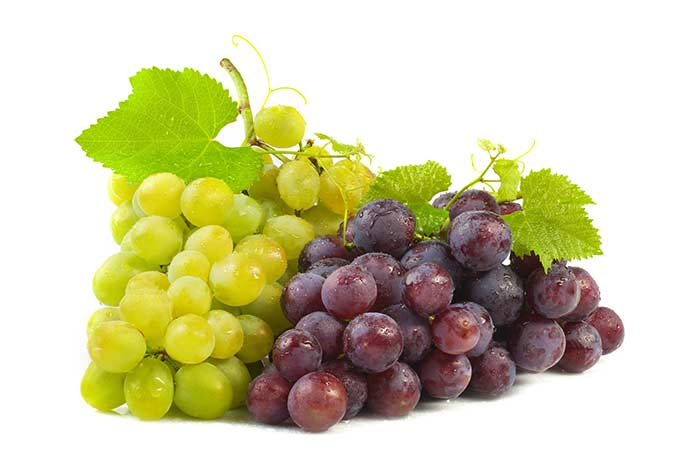
Jump to:
When are grapes in season?
Grapes start to show up in June in some areas, like Texas, with a big harvest in the second half of summer. Other areas see grapes a little later, starting at the end of July with peak harvest in August and September. In mild climates, the season can last into November.
Every state in the US grows grapes, so with some effort you might be able to find a local farmers market that sells them.
See what else is in season at the same time: June, July, August, September, October, November.
Harvest & sweetness
Most farmers pick grapes for grocery stores when they are around 14-17 Brix. Simply put, Brix measures the sugar concentration, the higher the number the sweeter it is. Farmers often pick grapes before they reach their peak sweetness and flavor because they store and ship better.
Wine makers, on the other hand, not only want the extra flavor to develop, but the higher sugar content ferments into more alcohol. Wineries pick grapes between 24 and 27 Brix.
How to pick grapes
Look for plump grapes that are firmly attached to the stem. To test this, shake the bag a little and see if a bunch fall off. Also the greener the stem the fresher the grapes (or at least, the better they were stored).
Store them in a perforated plastic bag they are usually sold in, or perforated plastic container in the fridge. They should last a week, possibly longer.
You don't need to buy the whole bag
Grocery stores put grapes together in bags, probably to keep loose grapes in the bag and to sell more. However, as long as your grocery store sells them by the pound, you can buy only what you need so you don't waste food and money. (Some people disagree and give you weird looks, but it's totally ok to do this).
If the store has a price-per-bag, then you can't move them around and need to buy the entire thing. This is rare, but some places do this.
Grape varieties
Red grapes:
- Concord - these have the characteristic grape juice flavor (which is made from these grapes). They have seeds, so be ready to eat them or strain them out if cooking into a recipe. Look for these at the end of summer or early fall. They are grown in the Northeast, Midwest, and East Coast.
- Champagne grapes - tiny little grapes (not associated with making Champagne though!). They are sweet and crisp. Look for them in Summer where they are grown (West Coast's Mediterranean climates)
- Crimson Seedless - the most common grape you'll find in the store. They were bred to show up later in the season and have thick skins to keep the berries from dehydrating when shipped and stored. Slightly tart with a long shelf life (but less flavor in my opinion).
- Flame Seedless - another common table grape, similar in flavor to Crimson Seedless, but it has an earlier season, making it one of the first grapes to ripen and show up in stores.
- Valiant - these are grown in Alaska and Canada. Their flavor is similar to Concords.
Green / white grapes:
- Cotton Candy - Keep an eye out for these from mid-July through September. The flavor really does resemble cotton candy. They have about 12% more natural sugar than other table grapes and almost no tartness (which makes them taste even sweeter yet). They're becoming more wide spread and have even shown up at Costco.
- Thompson Seedless - The most popular grape for raisins, and are one of the sweeter table grapes. Look for them from July through September.
- Muscat grapes are green with a rosy hue and taste like desert wine. They are hard to find but you might get lucky at a Whole Foods in fall, around September.
Keep an eye out for fun-flavored varieties slowly showing up in a store near you. The Grapery, creator of the Cotton Candy grape, has 12 varieties in commercial production. They have been a huge hit so demand and production should increase. The Sacramento Bee has an interesting feature on the Grapery.
Grape recipes
This year's collection has over 30 recipes including 3 versions of the Waldorf salad, a lot of roasted grapes, as well as some drinks and cocktails.

Leave a Reply